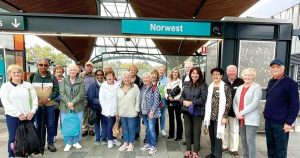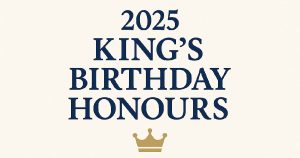Did you know that next to the present bridge (downstream side), beneath the noxious weeds proscribed by the D.P.I. and gabions placed there by the Council in the 1990s, are the remains of what is probably the oldest existing wharf in Australia? Further, that wharf was commissioned by Lachlan Macquarie, designed by Francis Greenway, built by John Howe (Howe’s house) and James McGrath (McGrath’s Hill). Did you know that it predates Port Arthur (a gazetted heritage site) by 30 years and was built in the same year as the oldest surviving house in Sydney, Cadman’s Cottage? How would you feel if other Greenway designed structures were to be destroyed without attempts at salvation or preservation??
The Windsor Bridge Replacement Project will see much of the construction infrastructure located exactly where the surviving archaeological remains currently exist. The remains are probably of the oldest surviving evidence of the importance of the maritime trade in European Australia in general, and more specifically, evidence of the importance of the river trade in the Hawkesbury District, supplying food stuffs to the starving colony until passable roads could be constructed.
As late as the 1920s the Fruit growers Association petitioned Council to improve the wharf so that their produce could be transported to Sydney more quickly. They were prepared to pay wharfage fess or support some of the costs. The Council voted against the motion.
The Early History:
In the earliest days of the Green Hills settlement, there was a sandy beach near the present bridge, onto which boats from Sydney were pulled ashore. Soon a wharf was built (1795) to allow boats to tie up and unload their cargo without the inconvenience of having to be beached. The construction of this first allowed for supplies to be unloaded safely at the early store and military garrison, while allowing for farm crops to be exported out. This was known as the Green Hills Wharf. However, this early wharf was ultimately washed away by floods (1799). The presence of a wharf at Windsor was an important infrastructure development that was part of the early settlement and development of the township.
Governor Macquarie instigated tenders for a Government contract to construct a better wharf on the exact same site. The wharf ran parallel to the bank, rather than a pier (which would have extended finger- like into the river). It was designed to allow large cargo vessels (up to 100 tons) to pull alongside, from which drays would take their cargo up the Punt road to Thompson Square and beyond or in reverse, goods could be loaded from the Hawkesbury farmers to take to the Sydney settlement. The construction this more substantial wharf in ca.1814-1820 was part of the formalisation and development of the Macquarie town. The early wharves evidence the importance of river transport and trade both to the Green Hills settlement’s survival and the survival of the settlement at Farm Cove, both from the time before viable roads provided land links and later, up until the time of the 1867-1870s floods, when the river silted up to the extent that large draught ships were no longer viable.
The wharf was an integral part of the Windsor township until the expansion of rail to Windsor and larger maritime infrastructure at Brooklyn on the Hawkesbury River meant the use of the wharf was likely limited to public recreational uses. However, the wharf remained of local significance until the 1950s. Windsor prospered as a busy port for small river craft. Goods were unloaded at the wharf where most of the produce was to be transported by rail from Windsor to Sydney. Cargoes included maize, poultry, watermelons, fruit, eggs, bark and gourds. Windsor also developed a boatbuilding industry, as did Richmond and Pitt Town. The Hawkesbury boats were smaller craft than those being built in Sydney, most being less than 50 tons, but they were suited to the river trade.
Early References:
Returns of the Public Works undertaken in Windsor state that:
“A wharf was constructed there in 1815 for the sum of one thousand, one hundred and seventy nine pounds and 10 shillings.” Construction for this new wharf began in 1814 and was nearly completed by 1815.The fact that the first government contract from 1814 survives, is a very significant fact in itself.
Governor Lachlan Macquarie described this new structure as:
“ a large substantial wooden wharf or quay constructed in the centre of town on the right bank of the Hawkesbury River for the convenience of vessels and boats, trading to Windsor, at which quay vessels of 100 ton burthen can load their cargoes. A very convenient ferry has been established from the same wharf to the north bank of the river by a large punt”.
The contract was undertaken by John Howe and James McGrath, both local residents who were involved in a number of other construction works. They were able to purchase 5,000 five inch iron spikes from the stores.
The original construction of the design of the wharf from the contract states: “The front of the Square to be piled with sound piles from 16 to 18 inchesthick to be from three to four feet apart in the (illegible) to be three feet above the Water Mark at Spring Tides (but in a line with it). Well capped and Secured by Land Ties to extend from side line to side line of the Square to be planked on the Inside of the Piles and then filled up to the top. “The Wharf to Commence from the Upper Side Line of the Square to Extend Eighteen feet from the above row of Piles which will be in deep water to extend fifty feet in length to be planked on the inside and filled up unless it should be thought best to plank the top and in that Case the same is to be planked and not filled up, the whole to be Capped and well secured by Land Ties as also to the Row of Piles in the Front of the Square”
On 14th November 1816, Macquarie wrote that a good part of the partially constructed wharf was carried away by a June flood (again!) So he commissioned the govt. civil architect, Francis Greenway: “to draw up a new plan for the contractors to follow and allowing them iron and spike nails as can be spared from the stores, plus the assistance of some carpenters”. Howe and McGrath were paid an additional sum of 220 pounds sterling to assist them to pay for additional iron spikes and nails as could be spared from the stores, plus an extra carpenter and 2 sawyers to enable the wharf to be completed in 8 months. They were somewhat disgruntled that the new structure was more grand than the original contract, yet they were not given an extension of funds to meet their additional costs!
The wharf was completed by 1820, if not before.
The archaeologist Higginbotham (1986) concluded about the remains evident today: ” the timbers are secured by hand made bolts and spikes which definitely date to 19th century and probably to the wharf built by Howe and McGrath to the Greenway plan between 1816-1820”.
The Importance:
The remains provide a rare example of early methods of wharf construction still evident. There may be quite significant construction evidence further into the river bank behind the wharf, currently hidden from view by the gabions installed in the 1990s. There may also be archaeological remnants from the 1795; evidencing even earlier construction methods within 7 years of settlement, when tools, resources, skilled people were very rare. Archaeological potential relating to the construction and use of both the 1795 and ca. 1814-1820 wharf probably exist on site. Physical evidence that has survived in the archaeological record has the potential to provide new information relating to construction techniques and material that were used, specifically in relation to types of wood used, fastenings, bracing and pile information as well as quality of workmanship and materials. Information relating to repair work to the wharf can also be determined from the remains in the archaeological record on wharf sites, such as from the driving in of repair “sister” piles or the addition of extra bracing or fastenings. Artefacts discarded, accidentally or deliberately, from the wharf and vessels moored alongside can contribute towards knowledge of the variety of traffic and goods that passed between Windsor and Sydney over time and has the potential to contribute to a greater understanding of settlement before and during the Macquarie era.
At low tide, some of the timbers can be seen from the opposite river bank. They should not fall victim to the infrastructure planned for the construction site of “Option One”.
The Windsor Macquarie/Greenway Wharf should not be yet another victim of heritage vandalism.









